Imagine a friend raving about a new café in town. You trust their opinion so you decide to visit. This simple act of sharing recommendations is what word-of-mouth marketing is all about. It’s powerful because people trust each other more than ads.
Word-of-mouth marketing works through “social proof.” We look to others for guidance, thinking that if many people like something, it must be good. Brands that make us feel strong emotions get three times more word-of-mouth marketing than others.
But this type of marketing has its challenges. A single bad review can be as powerful as a good one. To show you just how effective word-of-mouth marketing is, we’ve put together a list of word-of-mouth stats for you.

What is Word-of-Mouth Marketing?
Word-of-mouth marketing (also known as WOMM) is when people talk about a product or service they like. It’s not just casual chatter—it’s powerful because it comes from personal experiences and trust.
When you recommend a restaurant because the food blew you away or share a new gadget that changed your life, you’re influencing others without even realizing it.
Businesses love this type of marketing because it’s authentic and persuasive. Instead of flashy ads that people might ignore, word-of-mouth suggestions carry weight because they come from real customers.
Studies show that 88% of people trust recommendations from friends and family more than any other form of advertising. And this creates a domino effect: one recommendation leads to more, building a network of positive feedback.
General Word-of-Mouth Statistics
When your happy customers spread the word about your services, they’re giving your brand free promotion through word-of-mouth. Understanding the stats behind word-of-mouth marketing gives you real-life examples and insights you can use directly in your business.
These numbers show what your audience likes, helping you create strategies that really connect with them. Below, you’ll find key insights about word-of-mouth marketing and effective ways to engage your target audience.
1. According to Nielsen, 92% of consumers rely more on suggestions from friends and family than on advertising.
2. About 50% of marketers believe that between 20% and 40% of the leads they get come directly from these personal recommendations.
3. McKinsey & Co. found that word of mouth influences a large chunk, between 20% to 50%, of all the decisions we make when buying things. It goes to show how influential conversations can be in shaping our choices.
4. 23% of consumers share their favorite products with friends and family every single day.
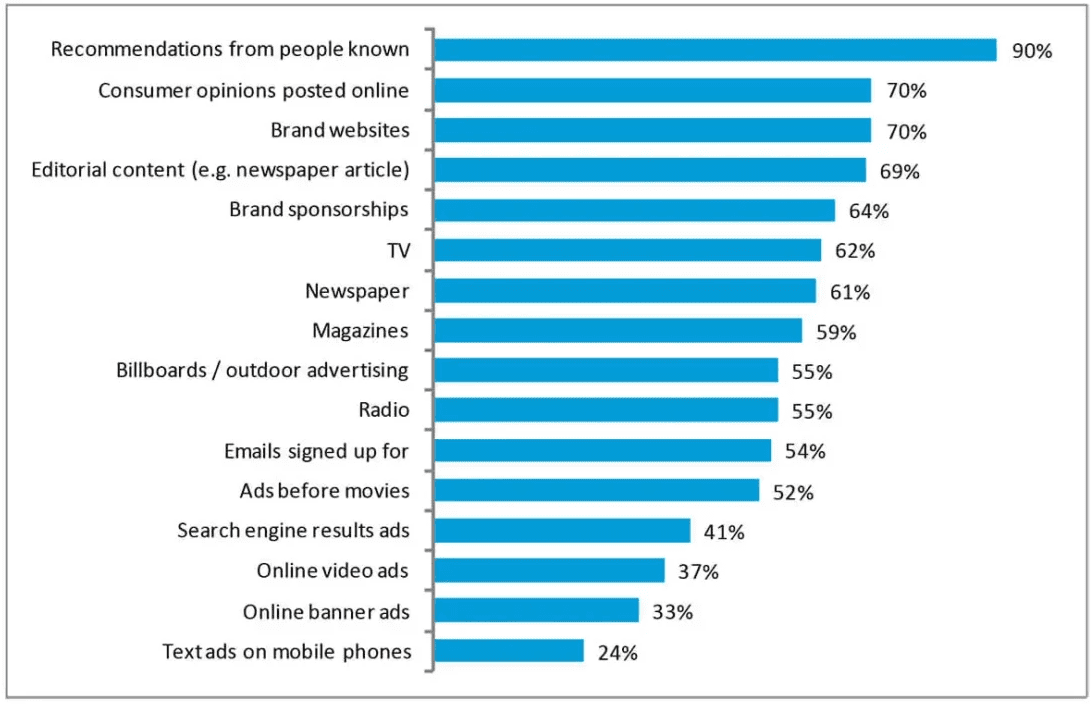
Source
5. If someone hears a negative story about a brand from a friend or family member, 26% of people will actually avoid buying from that brand.
6. When it comes to marketing impact, word-of-mouth actually leads to five times more sales than paid advertisements.
7. Globally, 88% of people trust personal recommendations more than any other form of communication.

Source
8. Millennials, in particular, are influenced a staggering 115% more by word-of-mouth marketing compared to traditional advertising methods.
9. Recommendations are trusted by 50% more people than other forms of advertising like flashy ads and SMS messages.
10. Keywords Everywhere reveals that word-of-mouth marketing has shown steady trend data over the past 12 months.
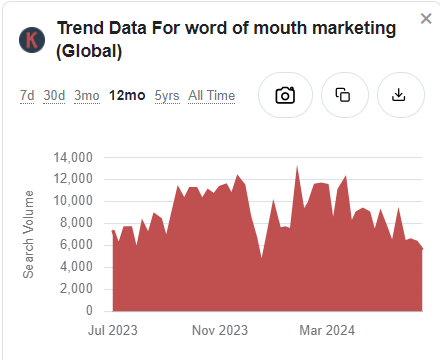
Word-of-Mouth Statistics For Business
Word-of-mouth (WOM) marketing is truly the best way for brands to connect with customers and increase sales across different industries. The way brands communicate with customers is changing. As people trust traditional ads less, word-of-mouth marketing through social networks and natural sharing has become incredibly effective.
Let’s explore these stats to understand just how valuable this marketing can be:
11. One out of every five businesses uses word-of-mouth marketing in their yearly plans. They know it helps spread the word effectively.
12. For B2B marketers, about one in twelve finds word-of-mouth great for promoting live events. It shows its influence in professional settings.
13. In the U.S., almost half of all businesses (48%) say word-of-mouth is their best marketing tool. It builds trust and credibility.
14. Referral programs bring in lots of new leads for 60% of marketers. Customers love recommending businesses they trust.
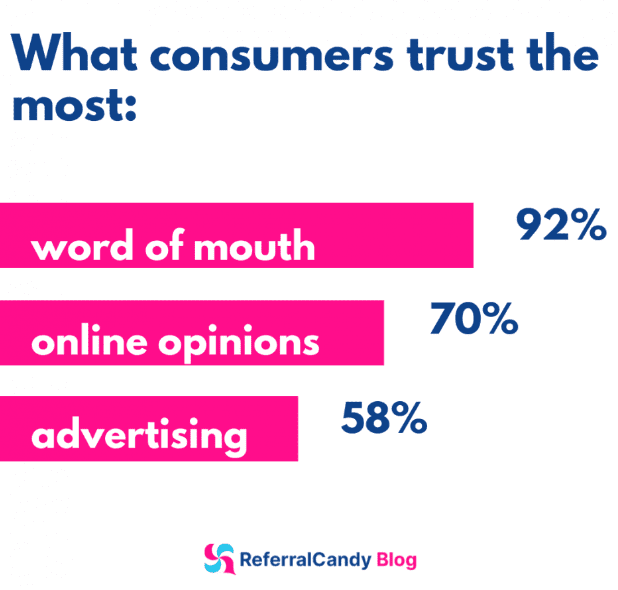
Source
15. Customers who come through referrals spend about 16% more over their lifetime. They tend to be more valuable.
16. Nearly 78% of B2B marketers rate referral programs as sources of really good leads.
17. Referred customers contribute about 25% more to a company’s daily profits. They help businesses make more money every day.
Reviews & Word-of-Mouth Statistics
Before nearly every shopper buys something, here’s a common thing they do—they read reviews. Whether it’s chatting on Facebook or leaving feedback on Yelp, your past and current customers are sharing their opinions where others can see.
These reviews play a huge role in helping people make up their minds about purchases nowadays. That’s why it’s smart for businesses to actively ask for and handle reviews as part of their word-of-mouth marketing plan.
Here are some stats that show just how crucial reviews are for businesses:
18. 80% of customers trust online reviews just as much as recommendations from their closest friends. 88% of people read reviews before making a purchase, and nearly everyone prefers businesses with 5-star ratings on Google.
19. Products that have at least 50 reviews tend to sell better. This tells us that having more reviews not only boosts sales but also creates trust among buyers.
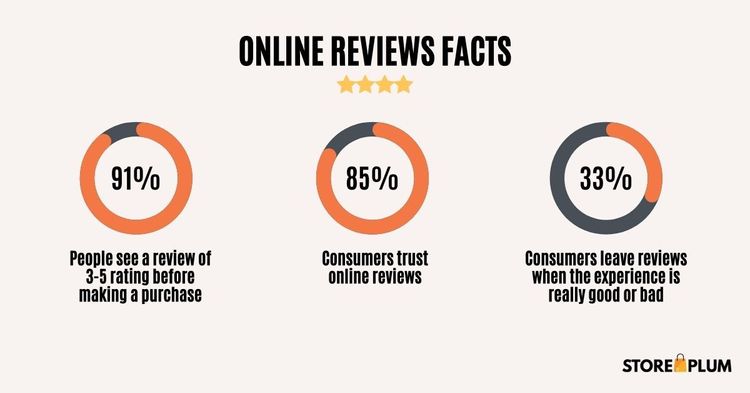
Source
20. After people read reviews, they’re twice as likely to buy something. And get this—68% of consumers trust reviews more when they notice both good and bad scores. Surprisingly, negative reviews can even increase sales by 67%, making the overall review scores more believable.
21. Reviews have a major impact on local restaurants. They influence where people decide to dine out. But for chain businesses, reviews have less of an effect. Each star a business earns on Yelp can increase their revenue by 5% to 9%. That’s how important those star ratings can be for a business’s success.

Source
Social Media & Word-of-Mouth Statistics
The concept of “word of mouth” has totally changed in today’s digital world. It used to be just about chatting with friends and family. Now, it’s all about social media.
Social media is the new word of mouth. It influences opinions, shapes perceptions, and drives actions like never before. Here are some key stats about how social media and word-of-mouth marketing work together:
22. About 71% of people are more likely to buy something if they hear about it through social media.
23. When friends post about products on social media, it influences 81% of people’s decisions to buy.
24. 56% rely on word-of-mouth from offline sources like conversations with others. But when they include online word-of-mouth, like reviews and social media, that number jumps to 88%.
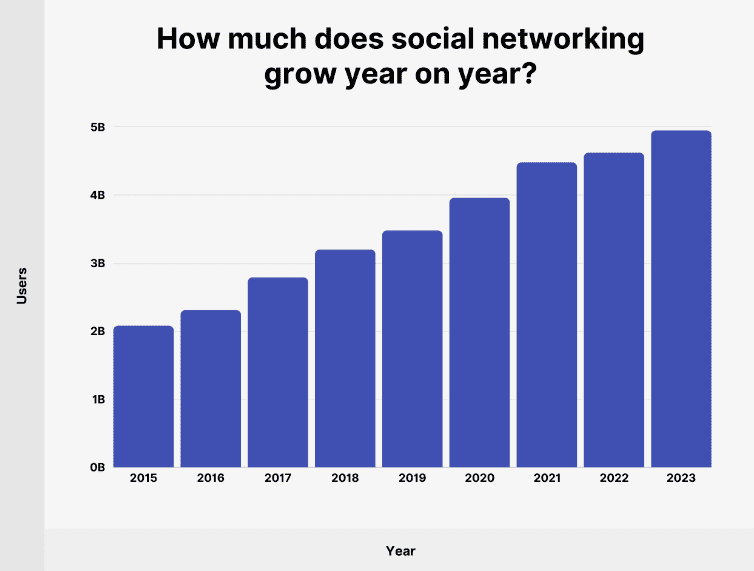
Source
25. On social media, 58% of consumers share their good experiences with companies. They often ask their friends and family for opinions about brands, showing how much they value recommendations.
26. About 43% of social media users have bought something after sharing or liking it on platforms like Facebook, Twitter, or Pinterest.
27. When people see something on social media and decide to buy it, more than half of those purchases happen within a week of seeing the post. And 80% of these purchases happen within three weeks.
28. 85% of people find user-generated content—like photos and videos from regular people—more convincing than content directly from brands.
Influencers & Word-of-Mouth Advertising Statistics
Simply put, word-of-mouth influencer marketing is when you team up with creators to make genuine and honest content that promotes your brand, services, or products. This helps you tap into the strong trust they’ve built with their followers.
Working with creators is a guaranteed way to boost your word-of-mouth marketing. Not convinced? Look at these stats about influencer marketing and see for yourself!
29. Over the past three years, there’s been a huge surge in interest for “influencer marketing” on Google, with searches increasing by an incredible 1500%.
30. According to Keywords Everywhere, people are searching for “influencer marketing” and related terms a lot, which means it’s a hot topic with high search volumes and costs per click.

31. 17% of companies are planning to spend more than half of their yearly marketing budget on influencer marketing campaigns.
32. For millennials, YouTube influencers are a big deal—60% of them trust advice from YouTube influencers more than traditional media personalities.
33. 80% of customers have bought something because an influencer recommended it.
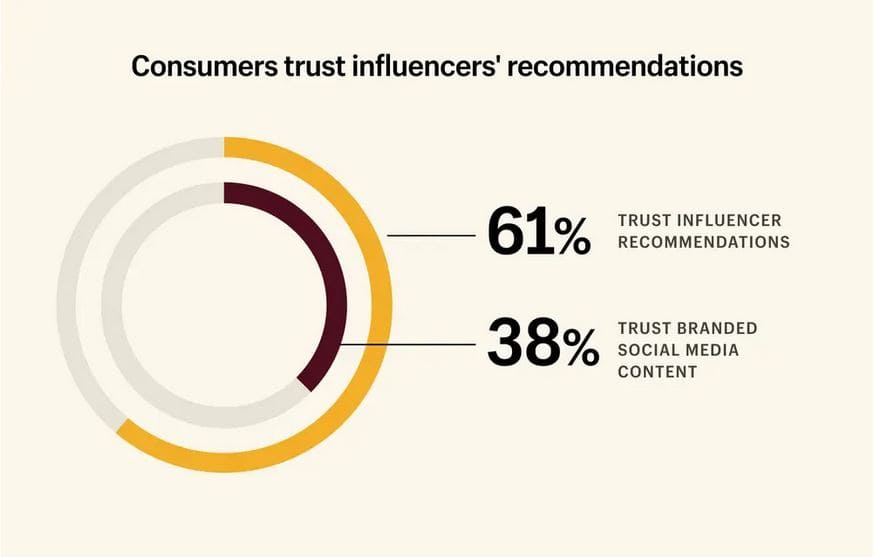
Source
34. When brands repost content from influencers, those posts perform 10 times better than the brand’s original content. This shows how much more engaging influencer content can be.
35. Influencer marketing gives a return on investment (ROI) that’s 11 times higher than other online marketing strategies. It’s clear that influencer marketing is not just a trend—it’s a powerful tool for businesses.
Brand Discovery Through Word-of-Mouth Statistics
One of the oldest and most reliable ways people discover new things is through word of mouth. Even in today’s digital age, recommendations from friends, family, and coworkers play a big role in shaping what consumers choose to buy. Around 25% of all internet users across different age groups discover brands this way.
Personal recommendations usually come from positive experiences with a product or service. When people have a great experience, they often share it with others, who might then become new customers.
Here are some important stats about how people find brands through word of mouth.
36. For 27.4% of consumers, word-of-mouth is the third most common way they discover brands.
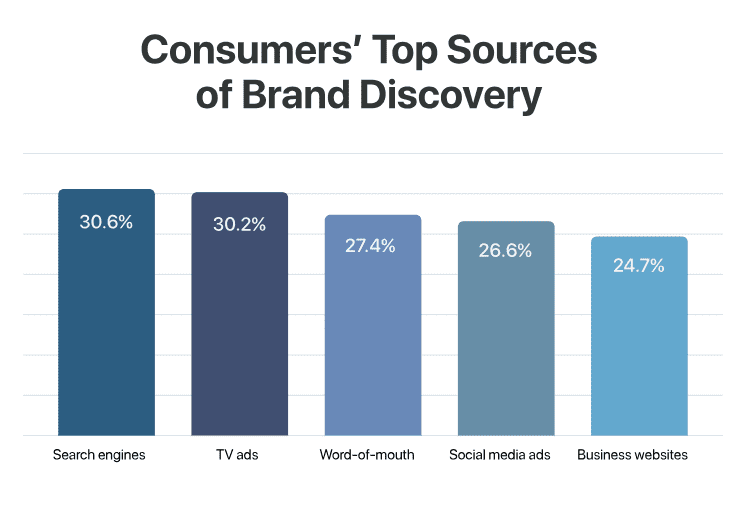
Source
37. Millennials are particularly influenced by recommendations from friends and family. They’re 38% more likely than other generations to discover brands this way.
38. Among different age groups, Generation X stands out for discovering products through word-of-mouth. About 18% of them regularly find new brands this way, showing how influential personal recommendations are for this generation.
39. On the other hand, Generation Z doesn’t rely as much on word-of-mouth for brand discovery. Only 12% of them find new products through this method, preferring other avenues like online reviews and social media.
40. Even Baby Boomers, at 16%, still find word-of-mouth recommendations important for discovering new brands that align with their interests and needs.
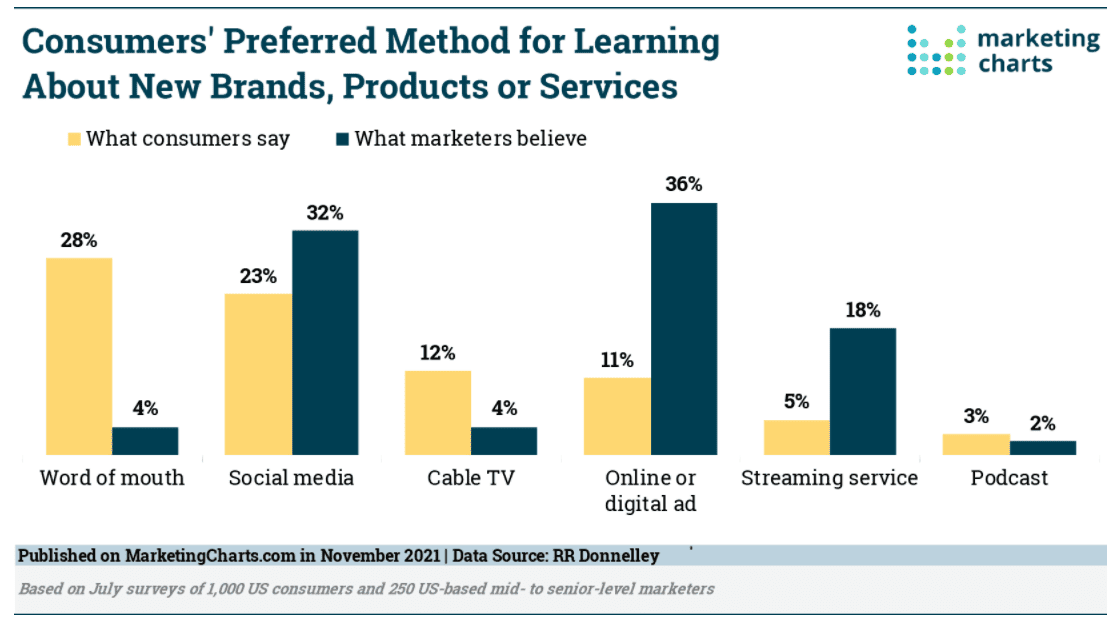
Source
41. 20% of people learn about smartphone apps through word-of-mouth recommendations.
Brand Loyalty Through Word-of-Mouth statistics
Customer referrals and retention are crucial for business success. A customer referred by word-of-mouth tends to be more loyal and valuable over time compared to others. Brands that prioritize customer referrals often see higher rates of customer retention and increased spending.
Here are some key statistics illustrating how word-of-mouth can enhance customer loyalty and retention for brands.
42. Customers referred through word-of-mouth have a lifetime value 25% higher than other customers.
43. Customers referred by existing customers have a 37% higher retention rate.
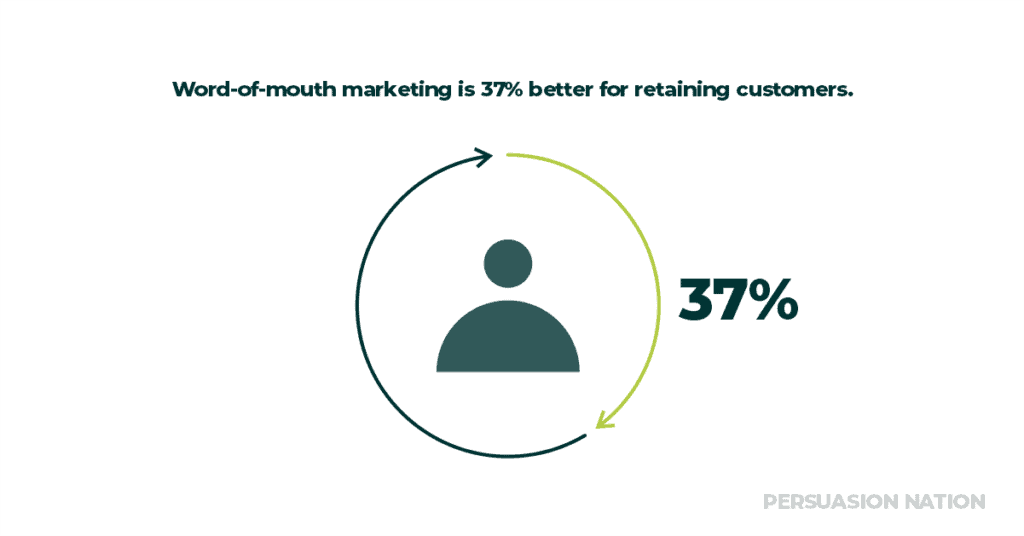
Source
44. Customers acquired through referrals spend 200% more compared to the average customer.
45. 28% of people believe that word-of-mouth increases brand affinity, aligning customer values with a brand.
46. 65% of consumers have stopped supporting a brand after a single bad experience, highlighting the critical importance of delivering exceptional customer experiences.
47. 85% of Facebook fans of brands actively recommend those brands to others.
Word-of-Mouth and Return On Investment
In the past, word-of-mouth marketing relied solely on consumers sharing their favorite brands or products because they genuinely liked them. Nowadays, many marketers offer rewards to encourage customers to spread the word.
Doing word-of-mouth marketing well isn’t easy, but when it clicks, it can be a game-changer for any business. The best part? It can bring in great returns without spending much on ads.
Check out these interesting statistics about word-of-mouth marketing and how it pays off:
48. Word-of-mouth is a powerhouse in global spending, driving $6 trillion in sales every year, which makes up about 13% of all purchases worldwide.
49. Interestingly, twice as many sales come from people recommending products to each other than from paid advertisements.
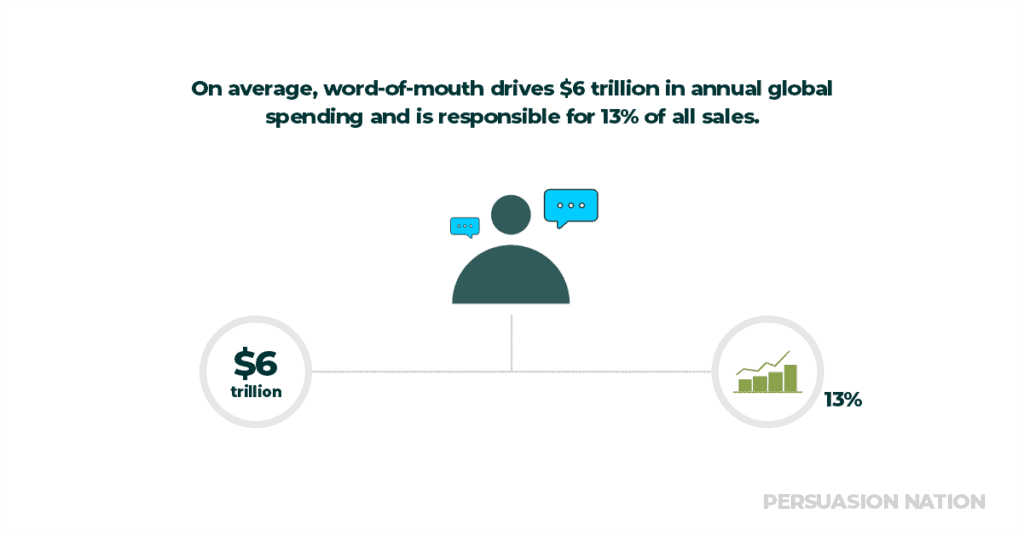
Source
50. When you’re deciding what to buy, you’re not alone if you listen to what your friends and family say; in fact, 74% of people say that recommendations from others really impact their choices.
51. About 82% of them use word-of-mouth strategies to help more people learn about their brands, and almost half of them hope this will lead to more sales directly.
52. Studies found that if word-of-mouth about a product goes up by just 10%, the sales of that product can go up by anywhere from 0.2% to 1.5%.
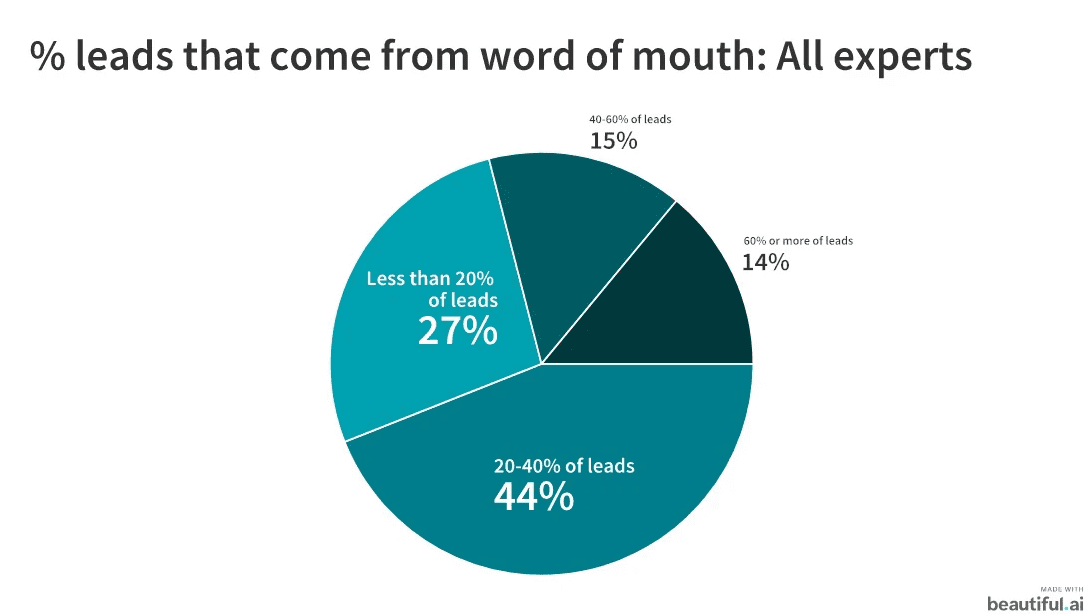
Source
53. 72% of consumers rely on recommendations from friends and family for product information, making word of mouth the most popular information channel.
54. Among Millennials, word of mouth is the primary influencer in purchasing decisions across all categories.
55. For Boomers, word of mouth holds power particularly in decisions involving financial products and significant purchases.
Conclusion
As we’ve seen, word of mouth is key to how people see your brand. When your friends say something is great, you’re more likely to believe them than if a company says it about itself. It’s all about trust and real experiences.
That’s why businesses are really getting into encouraging word of mouth. They’re setting up programs where you get rewards for telling others about their stuff, like referring friends or teaming up with influencers.
This approach isn’t just about boosting their image—it’s about building trust and making customers stick around. Word of mouth isn’t new, but it’s more important than ever in today’s marketing game.


